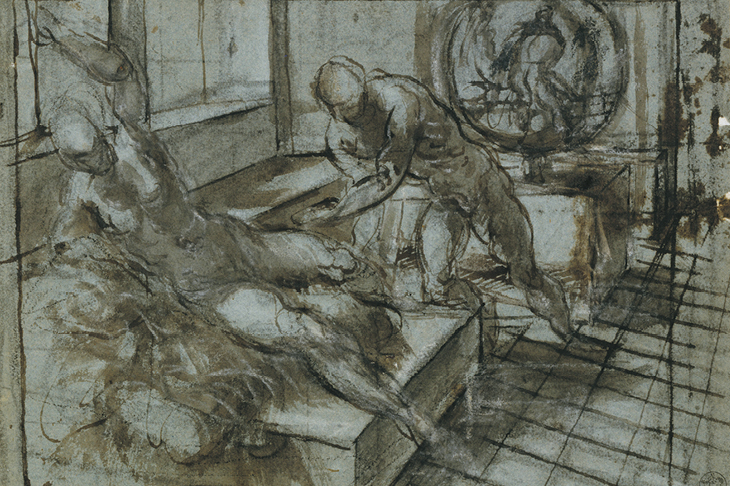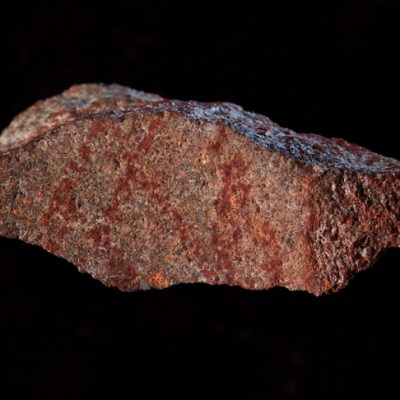In Carlo Ridolfi’s biography of Jacopo Tintoretto (c. 1519–94), he reported that his subject had declared: ‘fine colours were sold in shops at the Rialto, but […] disegno was brought forth from imagination’s hidden store and with much study and long hours.’ Ample evidence of Tintoretto’s imaginative skills and work ethic are provided in the splendid exhibition devoted to his drawings at the Morgan Library in New York (which travels to the National Gallery of Art in Washington in the spring). It forms part of the widespread celebrations of Tintoretto’s achievement, commemorating his birth, which include the major paintings exhibition in the Palazzo Ducale, Venice, and the show focusing on the artist’s portraiture in the Lehman wing at the Met. These projects provide analysis of complementary aspects of his work, while the Morgan show also sets it in the broader context of Venetian draughtsmanship of his age. Tintoretto emerges as a deft and sprightly draughtsman, who poured considerable energy and thought into conceiving his works and did not simply paint without preparation, as has often been assumed since Vasari formulated his view of Venetian art as dependent on colore rather than disegno. Tintoretto is also shown to have established a style of drawing that appears idiosyncratic and fizzing with energy by comparison with that of some of his peers.
Jacopo Robusti was born in Venice and spent most of his working life there. His nickname, Tintoretto, refers to his father’s profession as a dyer of cloth (tintore). It pinpoints him as coming from a family of tradesmen – indeed, a trade that was emblematic of Venice, as it involved using colour or pigments for business. He painted altarpieces, religious narratives and portraits, most famously being employed to enrich on a vast scale the Scuola Grande di San Rocco and the Palazzo Ducale. He also found patronage for smaller devotional paintings and is generally perceived as a man of devout if not passionate religious sensibility. Flickering, rapidly applied brushwork, locating his figures before darkened backdrops and maximising the drama and visceral engagement of the narratives he tackled became hallmarks of his mature approach and style on canvas.
Seated Male Nude (c. 1549), Jacopo Tintoretto. Musée du Louvre, Paris

Bravura speed of execution is also one of the key characteristics of his drawings, but such an approach did not dilute incisive thought or penetrating observation. The evolution of his approach to draughtsmanship is contextualised at the opening of the show, where a backdrop of other artists’ drawings is laid out for comparison, including works by Titian (exemplified by the Fitzwilliam Museum’s powerful embracing couple), Paris Bordone and Andrea Schiavone. Later works by the Bassanos and Paolo Veronese give further contemporary context. Tintoretto emerges from this highly competitive, experimental environment as a fully formed artistic individual in the 1540s, with great studies such as his Venus and Vulcan from Berlin, a dynamic compositional study in which the elevated viewpoint, animated figures, dramatic lighting and complex perspective all attest to his restless, radical imagination. From a few years later comes the artist’s Seated Male Nude, loaned by the Louvre, a heroic, agonised figure – to some degree comparable with studies by the somewhat older Pontormo rather than with any of his immediate Venetian contemporaries – which demonstrates his brilliance at working from life. It is hung beside an oil painting from a private collection in which Christ is similarly posed; it is one of the pleasures of this exhibition that works in oil are strategically placed amid the drawings.
Tintoretto was fascinated by studying sculptural precedents and according to early biographies he built up a considerable collection of models and casts after both antique sculptures and the works of Michelangelo, using them to inform his own draughtsmanship as well as for teaching. The exhibition features fine examples of both, rightly so, since the artist’s respect for Michelangelo’s work in particular was profound and important as a key to his conception of the heroic nude, but also because it breaks down crude perceptions which too neatly distinguish Venetian from Roman or Tuscan art.
Pietà (c. 1570), attributed to El Greco. National Gallery of Art, Washington, D.C.

As Tintoretto’s practice as an artist expanded – and he literally worked on larger and larger canvases – a team of assistants became key to the delivery of commissions. Among them was his competent son Domenico, examples of whose works are usefully included in the exhibition; his two studies of Venetian forces attacking Constantinople (from the NGA in Washington) are especially robust and impressive. Domenico Tintoretto is, however, outshone by Palma Giovane, who is presented as the most competent of Tintoretto’s artist heirs and a draughtsman capable of great delicacy and pathos in both his secular and sacred works. More controversially, the exhibition also features works from Tintoretto’s circle which were, it is suggested, created by El Greco during his formative Venetian period. This proposition, which has been developed by Nicholas Turner, is a provocative coda to the survey that has by no means yet found universal support, but which makes the point that Tintoretto’s art was to inspire a wide range of talented artists from the next generation.
The exhibition is complemented by a very attractive catalogue, which takes the form of a sequence of absorbing essays on its main themes by the curator John Marciari, followed by a checklist with provenances of the 72 exhibits. This project comes in the wake of the outstanding survey of Venetian drawing undertaken by Catherine Whistler and published in 2017; the two should undoubtedly be studied alongside each other.
Like many Old Master drawings shows, this one raises questions of attribution, dating and function, which will no doubt be extensively debated; but the overall benefit of a project like this is clear. It allows an intimate engagement with Tintoretto’s creativity, at the heart of which is his endlessly inventive study of the human form and ability to choreograph complex casts of animated figures in his grandest compositions. The two dimensions of a sheet of paper were never a constraint, as he grappled so effectively with the issue of how to place figures in space or indeed make them spin in mid-air and almost tumble into our world.
‘Drawing in Tintoretto’s Venice’ is at the Morgan Library and Museum, New York, until 6 January 2019.
From the December 2018 issue of Apollo. Preview and subscribe here.



